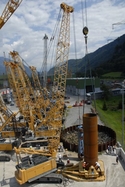Liebherr Nenzing celebrates 35th in high-tech style
4 October 2011Liebherr recently celebrated the 35th anniversary of its production facility in Nenzing, Austria, which produces mobile harbour, ship, offshore and crawler cranes while developing industry-leading technologies such as carbon fibre crane parts.
Liebherr Nenzing began as a producer of marine equipment along with other facilities Sunderland, Rostock, and Killarney.
Expanding continuously, Nenzing now houses a growing foundation equipment segment, and a crawler cranes segment comprising lift cranes (LR-Series) and heavy-duty cycle crawler cranes of up to 300t capacity (HS-Series).
The use of carbon fibre for crawler cranes is a recent development for the facility. Cutting edge materials such as lightweight fibre carbon and nanotubes will eventually make stronger-than-steel parts, already available as pendants in the newly launched LR 1300 crawler and HS 895 HD duty cycle crawler, cheaper, increasing lifting capacities by up to 50%.
At the press conference, Walter Lange, managing director of technology at Liebherr Nenzing, said production may evolve to make other fibre carbon components.
“New structural parts made from fibre materials are under development,” said Lange. “Thus far, glass fibre reinforced plastic (GRP) allows not only for the production of optimal forms, but also has useful characteristics such as noise reduction and corrosion resistance.”
Strategic consolidation and automation of crawler production in 2009 has further strengthened the land cranes segment. “We have built a new fabrication hall, fabrication hall nine, for the comprehensive manufacture of booms for lift cranes and duty cycle crawler cranes,” Lange said.
Owing to consolidation, boom foot sections, intermediate sections and heads for crawlers are now manufactured exclusively in house rather than in Eastern Europe, enhancing capacities, improving quality, and optimising material flow. Parts that formerly travelled 3,000km now only need to travel a few kilometres.
Turning to the question of offshore cranes, Wolfgang Pfister, head of marketing, announced development of a new range leading to more intensive focus on the subsea sector. “We have recently been developing an Active Heave Compensation (AHC) system that is being implemented in one of our new offshore cranes, which will be in a new range of offshore cranes. We are moving with this development in the subsea sector.” Liebherr demonstrated a prototype of the new AHC system on the testing ground.
Within its port equipment segment, Nenzing has in recent months launched the LHM 420 mobile harbour crane, which is serially equipped with the Patronic hybrid drive system capable of improving handling and producing enough energy to return some to the grid.
“A highlight of the LHM 420 is the hybrid system. It is the successor the LHM 400, our best selling mobile harbour crane, and perhaps the best selling mobile harbour crane,” said Pfister.
Electronics are becoming more advanced, Lange added, and wished to correct the misguided belief that electronics are unreliable. “The truth is that the most reliable components are electronics.” He explained that while the number of parts is the determining factor in the reliability of components, Liebherr keeps all control components on one unit.
Nenzing’s latest crane developments, such as the prototype of the new LHM 420 mobile harbour crane or the HS 8030 HD duty cycle crawler crane as well as the planned subsea crane type RL-K 7500, are currently in the development stage but will soon be available globally. Target markets for the cranes will also include the BRIC countries of Brazil, Russia, India and China, a spokesperson said.
